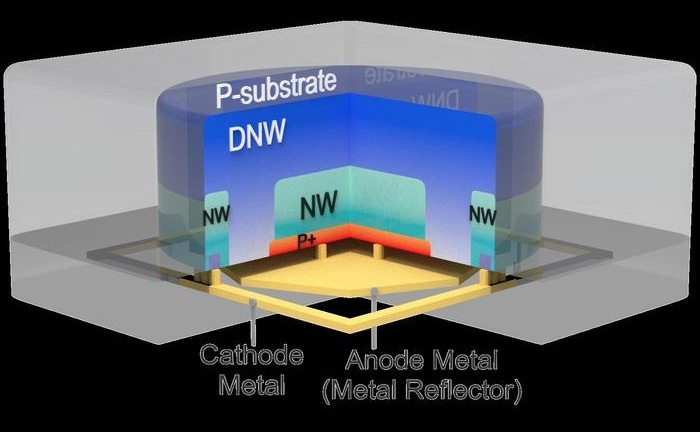LiDAR sensors are essential to implementing modern technologies like autonomous driving, AR/VR, and advanced driver assistance systems (ADAS). For example, more precise shape detection in AR/VR devices and smartphones depends on improved distance (depth) resolution from short- and mid-range LiDAR. This calls for a single-photon detector with improved timing jitter performance.
 KIST single-photon avalanche diode developed in SK hynix’s 40 nm back-illuminated CMOS image sensor technology. Image Credit: Korea Institute of Science and Technology (KIST)
KIST single-photon avalanche diode developed in SK hynix’s 40 nm back-illuminated CMOS image sensor technology. Image Credit: Korea Institute of Science and Technology (KIST)
By measuring how long it takes for a photon released by a transmitter to strike an object, reflect, and return to the receiver, LiDAR calculates distance and produces a three-dimensional picture. The more precisely an object can be identified, the less the value of “timing jitter,” which is the little variation in detection time that happens when the single-photon detector at the receiver turns the light signal into an electrical signal.
A group at the Post-Silicon Semiconductor Institute under the direction of Dr. Myung-Jae Lee has created a “single-photon avalanche diode (SPAD)” that can recognize objects at the millimeter level using a 40nm back-illuminated CMOS image sensor technique, according to Korea Institute of Science and Technology (KIST).
The development of SPADs—ultra-high-performance sensor devices with the ability to detect single photons—is extremely difficult, and only Sony of Japan has successfully commercialized SPAD-based LiDAR yet, supplying it to Apple products based on their 90nm back-illuminated CMOS image sensor technology.
While the timing-jitter performance of Sony’s SPAD is about 137~222 ps, it is not enough to realize user discrimination, gesture recognition, and precise shape recognition of objects required in short- and mid-range LiDAR applications. Sony’s SPAD is more efficient than back-illuminated SPADs reported in the literature.
With a timing-jitter performance more than two times faster at 56 ps and a distance resolution of around 8 mm, the single-photon sensor element developed by KIST has enormous potential for use as a short- to mid-range LiDAR sensor element.
Specifically, the SPAD is projected to be locally and commercially available right away since it was created based on the 40nm back-illuminated CMOS image sensor technology, a semiconductor technique for mass manufacturing, through collaborative research with SK Hynix.
If commercialized as a core source technology for semiconductor LiDAR and 3D image sensors, it will greatly enhance our competitiveness in next-generation system semiconductors, which are Korea's strategic industries.
Myung-Jae Lee, Principal Investigator, Korea Institute of Science and Technology
The study, funded by the Korea Institute of Science and Technology (KIST) Institution Program (Grant No. 2E32242) and the National Research Foundation of Korea (NRF) (Grant No. 2021M3D1A2046731), was highlighted on December 12 at the International Electron Devices Meeting 2023 (IEDM 2023), which took place in San Francisco, USA, from December 9 to 13, 2023.
IEDM is one of the most important conferences for the semiconductor industry and research professionals, attended by major worldwide semiconductor corporations such as SK Hynix, Samsung Electronics, and Intel.
Source: https://www.nst.re.kr/eng/index.do